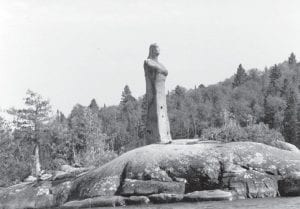Once again the picture of an impressive statue built on a small outcropping of rock in the middle of Brule Lake has caused a flurry of speculation and curiosity. The picture published in the Cook County News Herald in November was recently brought to the Cook County Historical Society museum in Grand Marais by Bob Olson of the Gunflint Trail. Olson said he had run across the picture and thought the museum should have it. He remembers seeing the Lady when he was paddling on Brule Lake in the late 1960s. He has a vivid memory of seeing the statue again when he was on a family canoe trip and is sure that he took the picture on August 27, 1984. He has a lot of questions that he would like to have answered. The statue is not a Native American treasure nor evidence of Norwegian explorers in the 1500s but even its picture has the power to inspire. Both the newspaper and the museum heard from a number of people and nostalgia reigned as people all around the county called up memories. Eric Frost remembers an article in the Minnesota DNR’s publication, The Conservation Volunteer. This is a short article entitled Mysterious Lady of the Lake and appears in the July-August issue of 1977. It says that William “Marty” Hagen of Duluth was curious about the statue and spent two years contacting every possible historical source in Minnesota with no success. As a last resort, he decided to check with an outfitter on Sawbill Lake. Bill Hansen is that outfitter today and his father, Frank, would have been the outfitter in 1977. As a kid in the 1960s, Bill spent time visiting our good friends Vi and Ken Osman in the family cabin at the west end of Brule Lake. Bill remembers the statue and Ken’s explanation that it was built as a lark when some management executives and friends were vacationing at the Pure Oil Company’s retreat. David Carlson of Tofte sent Gene Erickson a 1973 newspaper clipping from the Duluth paper that he had saved. Gene passed it on to the Cook County Historical Society. It fleshes out more details, backing up the other memories. A.J. “Art” Osman was the reliable source for the information in the Duluth paper because he was one of the builders. He was the president of Home Oil Co. in Rochester, a subsidiary of Pure Oil Co. in Minneapolis. Pure Oil had purchased an island in Brule Lake for a company retreat. Six people, all presumably from Rochester were vacationing there in 1942. Norman B. Curtis invited them. They were, in addition to Curtis and Art Osman, Dr. “Rags” and Mrs. Soderland, and Pure Oil employees Mike Blicker and Eddie Nelson. Bill Plouff, a resident of the area, was there as the “guide.” The guests probably arrived by airplane, the customary transportation to remote lakes in those days. There was no road for the last six miles into Brule except the abandoned railroad grade. It was Mrs. Soderland who, very impressed with the beauty and serenity of Brule Lake, suggested that they build an Indian maiden on the nearby rock outcropping. The men spent four hard days building forms out of orange crates and chicken wire, collecting loose rocks to fill the crates, purchasing bags of cement from Grand Marais and harvesting sand they found three feet under water to build the 12-foot high form. Mrs. Soderland, who had some experience with sculpture, carved out the head and upper body. She named the statue The Spirit of Brule Lake. The fact that the statue was still intact 42 years later in 1984 attests to its sturdy construction. Here is the background of the lady’s ultimate demise. In 1964, President Lyndon Johnson signed Public Law 88-577 protecting wilderness areas across the country and banning motor use from these areas. This is widely considered to mark the birth of the BWCA. However, exceptions for motor use were made and one was Brule Lake. The 1978 Boundary Waters Canoe Area Wilderness Act provided that motors could be used on Brule until January 1994, or until businesses already in operation were terminated. The Dinges family decided to build a modern resort on Brule Lake near the official access point, which they did in the early 1980s. Even after Sky Blue Water Resort was completed, they delayed opening it to the public until after a “real road” was built on the old railroad spur from the grade into Brule. That finally happened in 1983. Then the resort did open. By 1987, they were the last business left on Brule and they chose to sell to the government and remove all their buildings. This triggered the end of motors on Brule Lake and it reverted to the basic BWCA rules. Gradually all permanent structures found in the Boundary Waters were removed. Theoretically, this would have included the Lady of the Lake, but it seems that the U S. Forest Service in Tofte agreed to leave it in place as long as it survived. No one has pinpointed the date when it was actually removed, but that did eventually happen. The Lady of the Lake lives on in the memories of many Brule Lake visitors. The breaking news is that there may soon be a special display at the Cook County Historical Society museum, starring “The Lady.”
Local historian Mary Alice Hansen and her husband Frank Hansen established Sawbill Canoe Outfitters in 1957. Mary Alice was a founding member of the North Shore Commercial Fishing Museum in Tofte and has long worked to preserve the history of the North Shore.



Loading Comments